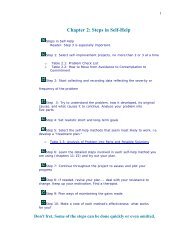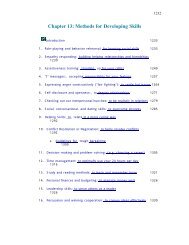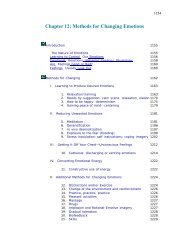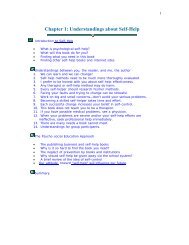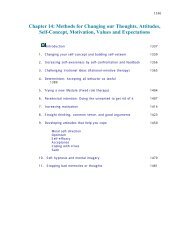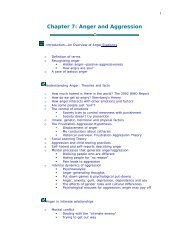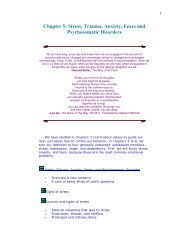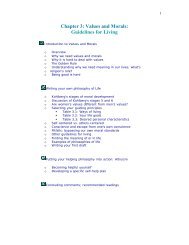Methods for Changing Behaviors - Psychological Self-Help
Methods for Changing Behaviors - Psychological Self-Help
Methods for Changing Behaviors - Psychological Self-Help
You also want an ePaper? Increase the reach of your titles
YUMPU automatically turns print PDFs into web optimized ePapers that Google loves.
Steps<br />
· To decrease a behavior, get it under stimulus control and then<br />
gradually avoid the stimulus. Example: Condition worry to one<br />
chair, then sit there less and less.<br />
STEP ONE: Identify the "controlling" response or the controlling<br />
"conditioned" stimulus preceding the behavior to be changed.<br />
What response does or could facilitate or interfere with the "target"<br />
behavior? Suppose you want to discuss current events more with<br />
friends...or tell more funny stories or jokes. Obviously, "controlling"<br />
responses might be to do some reading (newspaper, joke book, etc.)<br />
and rehearsing what you could say and then saying, "Hey, I've got a<br />
joke <strong>for</strong> you."<br />
What very specific situations could be associated with the wanted<br />
or unwanted "target" behavior? What easily produced stimuli could be<br />
paired with desired "target" behaviors? Examples: suppose you worry<br />
a lot, you could limit your obsessing to a particular place and time (say<br />
a certain chair). Suppose you are frequently critical and suspicious and<br />
distrusting of others, either openly or secretly. To counteract this<br />
distorted and inhibiting view of others, you could condition yourself to<br />
think something positive whenever you are in a certain situation, e. g.<br />
taking a drink of any liquid. Think positive with every sip and your<br />
view of others will be conditioned to be more positive.<br />
STEP TWO: Pair repeatedly the controllable stimulus with the<br />
"target" behavior.<br />
Here are some examples: Start limiting your worrying or feeling<br />
depressed to your "worry chair." Don't restrict the total time spent<br />
worrying (yet) but do restrict the worrying to that chair, as much as<br />
possible. This is conditioning the worry with the chair.<br />
Start pairing a positive, complimentary, trusting thought about<br />
others with some stimulus, e. g. taking a drink or seeing or thinking of<br />
a close friend. Eventually, it will become automatic but at first you will<br />
simply have to keep reminding yourself over and over...or practice by<br />
taking a sip or thinking of the friend and immediately having a positive<br />
thought. Prepare in advance a list of accurate, reassuring, caring,<br />
trusting statements to say to yourself.<br />
Start smoking a cigarette when a timer's bell sounds, rather than<br />
when you have the urge or see another person light up, see an ash<br />
tray, have a beer, etc. Smoke as much as usual, but get it conditioned<br />
to the bell.<br />
STEP THREE: Start using the "controlling" response; start<br />
changing the frequency of the controlling conditioned stimulus.<br />
1083



